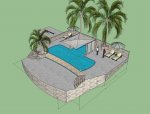I am going to be changing my pool from salt water to regular water. My fill water(well) has CH of 375. Is there a way to lower CH? Is there anything I can attach to my fill water before it enters the pool, like a water softener?
Is salt water heavier or lighter than regular water?
Also any suggestions on a good way to change out my water? I don't really want to totally drain my pool since I have a fiberglass pool and would have to brace it off quite a bit. Can I pump water out from the top(warm water) of the pool and place the fill hose(cold water) in the bottom of the pool. Warm water should stay higher than the cold water I would think? Kind of a crazy idea but any thoughts?
Is salt water heavier or lighter than regular water?
Also any suggestions on a good way to change out my water? I don't really want to totally drain my pool since I have a fiberglass pool and would have to brace it off quite a bit. Can I pump water out from the top(warm water) of the pool and place the fill hose(cold water) in the bottom of the pool. Warm water should stay higher than the cold water I would think? Kind of a crazy idea but any thoughts?



